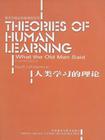人类学习的理论
2004-10
外语教研
勒弗朗索瓦
385
无
Updated discussion and evaluation of current theories such as connectionism (neural net modes);Thorough exploration of the development of behavioristic and cognitive theories;New material on evolutionary psychology and biology,Vygotsky,and theories of memory;Helpful,clearly labeled appraisal sections following each major theory;A story that opens each chapter plus objective;ommentary throughout by the Old Man to focus your attention,maintain your interest,and enrich your understanding of each theory.
Read This First导读Part OneThe First Words: Science and TheoryChapter 1 Human Learning: Science and TheoryThis ChapterObjectivesPsychology and LearningLearningPerformance Versus LearningTheoryTheories, Principles, Laws, and BeliefsPurposes ofTheoriesCharacteristics of Good TheoriesScience and the Development of Psychological TheoriesWhat Is Science?Rules of the Scientific MethodExperimentsThinking Critically About Psychological ResearchHuman and Nonhuman SubjectsEthics of Animal ResearchHumans as SubjectsLearning Theory: A Brief OverviewRecent Origins of Learning TheoryPreview of the TextSummaryMostly Behavioristic TheoriesChapter 2 Pavlov, Watson, and Guthrie:Early BehaviorismThis ChapterObjectivesThe Beginning of Scientific PsychologyEarly PsychophysicsIvan P. Pavlov (1849-1936)Classical ConditioningExplanations for Stimulus-Response AssociationsVariations in ContiguityAcquisition, Extinction, and RecoveryPavlovs Classical Conditioning: An AppraisalJohn B. Watson (1878-1958)BehaviorismA Classical Conditioning Explanation of LearningEmotional LearningTransferWatson s EnvironmentalismHigher LearningApplying Watsons PsychologyWatsons Behaviorism: An AppraisalEdwin Guthrie (1886-1959)Guthries Law of One-Shot LearningPracticeMovement Produced Stimuli (MPS)HabitsForgettingReward and PunishmentPractical Applications of Guthries TheoryBreaking HabitsGuthries One-Shot Learning: An AppraisalEarly Behavioristic Theories: EvaluationSummaryChapter 3 Thorndike and Hull:The Effects of BehaviorThis ChapterObjectivesEdward L. Thorndike (1874-1949)Animal lntelligenceContiguity or ReinforcementThorndike s Pre-19 3 0s TheorySubsidiary LawsThorndike s Post-1930 TheoryThorndikes Connectionism: An AppraisalClark L. Hull (1884-1952)Hulls System: An OverviewMain Components of Hulrs SystemGraphic Summary of Hulrs SystemInput Variables: PredictorsIntervening VariablesOutput Variables: The PredictedFractional Antedating Goal ReactionsHabit-Family HierarchiesHulls Formal Behaviorism: An AppraisalSummaryChapter 4 Skinners Radical Behaviorism:Operant ConditioningThis ChapterObjectivesIs Skinners Radical Behaviorism Antitheoretical?Overview of Skinners Radical BehaviorismReinforcementTypes of ReinforcementPunishmentIllustrations of Reinforcement and PunishmentSources of ReinforcementSchedules of ReinforcementContinuous or Intermittent ReinforcementEffects of Reinforcement SchedulesSchedules of Reinforcement in Everyday LifeShapingChainingShaping and PeopleFading, Generalization, and DiscriminationIllustration 1: Pigeons ReadingIllustration 2: Quail LovingRelevance to Human LearningThe Science Applied to HumansControl Through Positive ContingenciesControl Through Negative ContingenciesImitation and Operant ConditioningSources of Reinforcement in ImitationThree Effects of ModelsBehavior ManagementPositive Reinforcement and PunisbmentCounterconditioningExtinctionImitationSkinners Position: An AppraisalContributionsEvaluation as a TheorySome Philosophical ObjectionsSummaryChapter 5 Learning and Biology:Evolutionary PsychologyThis ChapterObjectivesLearning Taste AversionsConditioning Explanations of Taste AversionThe Phenomenon of BlockingEvolutionary PsychologyAutoshapingInstinctive DriftBiological Constraints in Evolutionary PsychologySociobiology: A Branch of Evolutionary PsychologyInclusive Fitness and AltruismCriticisms of SociobiologyEvolutionary Psychology: An AppraisalBiofeedback: A Practical Application of Conditioning TheoriesOperant Conditioning and Autonomic ResponsesHow Biofeedback WorksThe Beginning of a TransitionSummaryThe Beginnings of Modern CognitivismChapter 6 Hebb, Tolman, and the Gestaltists:Toward Modern CognitivismThis ChapterObjectivesHebbs Theory: A Look at Higher Mental ProcessesHigher Mental ProcessesThe Neurological Basis of LearningComponents and Functioning of the Central Nervous SystemPossible Neurological Changes Underlying LearningHebb s Neurophysiological AssumptionsReactivity and PlasticityMediating Processes: Hypotheses and AssumptionsHebbs View of Learning and ThinkingSet and AttentionHebb s Theory: An AppraisalFrom Behaviorism to CognitivismMechanistic BehaviorismTolmans Purposive BehaviorismDo Rats Have Purpose?Four Summary PrinciplesTolman s Purposive Behaviorism: An AppraisalBasic Beliefs of Gestalt PsychologyInsight Versus Trial and ErrorThe Whole Is Greater Than the Sum of lts PartsGestalt Theory: The Laws of PerceptionGestalt Views of Learning and MemoryBeyond Perception: The Psychological Field

无